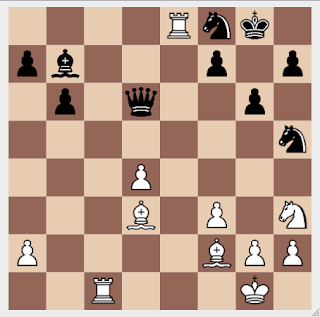I expected Round 9 to be a tough fight, because with the match tied so far, and only four more rounds to go, there were not many more chances to play hard for a win.
As I suspected he might, Anand gave up on the Catalan and decided to invite the Nimzo-Indian, and Topalov took him up on the challenge. The Nimzo-Indian is a good choice for either White or Black to play for a win, because in almost all variations, there are clear imbalances, primarily of White obtaining the Bishop pair and Black having a sounder Pawn structure. Anand played the classic Rubinstein variation, and Topalov played what I suppose we could call the Karpov variation, simply because Karpov made it his primary defense as Black back in the day.
The following thematic position arose out of the opening:
But in the space of a few moves, Anand "allowed" Topalov to obtain a very unusual middlegame, in which Topalov gave up his two Rooks for Anand's Queen:
What is important to realize is that even though your favorite chess engine (I prefer Rybka and Stockfish) might think the game is now dead equal, in the hands of human beings, there is a huge amount of play left. Also, personally I would much rather be White in this kind of position, because I think it is White's game to lose. Two Rooks, if made to work together, would be much more dangerous against the opponent's King than one Queen. On the other hand, one Queen can be very effective in forcing a draw with perpetual check, if the opponent's King is too exposed. Therefore, if I were White, I would try to get my pieces to work together (not get accidentally forked or something by the Queen) and checkmate Black, while keeping my King safe. Black's practical task is much harder. Black's only way to win, really, is to somehow create a Queenside passed Pawn and promote it. In other words, whereas White to win has to finish Black off before an endgame happens (by checkmating or by winning material as a result of checkmating threats), Black to win has to protect the King and reduce White's checkmating capabilities and enter an endgame in which somehow Queening the a-Pawn or b-Pawn occurs. These are the structural constraints implied by this position.
The following position, only a few moves after the Queen/Rooks trade above, illustrates more starkly the dangers for both sides:
Both sides have played well, and Black is trying to trade off White's dangerous two Bishops, and also is aggressively aiming his Queen at White's isolated a-Pawn and d-Pawn. Note that Black's aggression with the Queen does leave his King less well defended, however.
After some less than perfect play, in which Topalov mistakenly grabbed White's d-Pawn, the following position arose:
At this point, Anand started going astray, undoubtedly partly because of time pressure. He may have felt (correctly) that the win was within his grasp, but could not decide how to follow through. Instead of something like 33 Nxe6 (followed by f4) or the "obvious" 34 Rc8+ (followed by Rec1), he played the terrible 33 Ne4, allowing Topalov to painlessly take the a-Pawn, and a new phase of the game began, in which Black's King was still in danger, but Black also has a connected pair of passed Pawns, that given a huge amount of time, could become a Queening threat.
Sadly, in the rest of the game, Anand repeatedly could not find the best moves at many points (one has to understand how many hours this game took to complete, and how the burden of proof of the win always lay with White), Topalov repeatedly made some blunders that should have resulted in a loss, and finally, the game was drawn, by perpetual check.
Here is one of the won positions Anand had (in which Topalov had sacrificed a Knight for swindling possibilities):
Anand seemed at a loss in this position, and in time pressure and probably extreme fatigue, shuffled his Rooks around, allowing Topalov to keep on pushing his Pawns, until Anand had to give up his Knight for the Queened b-Pawn, and then when he won the a-Pawn by taking with the wrong Rook (!), the position was a dead draw with obvious perpetual checks on White's King, which has no hiding place:
A very tiring and exciting game! Much could be said about the errors by both players, but these wide-open positions with two Rooks against a Queen are extremely difficult for human beings (with constraints of time and energy) to calculate out perfectly. Computers can "see" the truth of these positions in a split second, but what we're watching is human chess, not computer chess.
So, three more rounds to go. I stand by my assertion (before this round) that Topalov has an advantage. Anand cannot be feeling happy that he expended so much energy failing repeatedly to find a win in won positions, and he has only one White left. Topalov must be unhappy that he repeatedly played losing moves, but he got his draw, after all, and has two Whites left, so I would expect that he is less unhappy than Anand. What next? I imagine that Topalov would be pleased to try again to smother Anand's Slav defense, since he succeeded the last time. Furthermore, Anand may feel that he needs to get out of his "passive as Black" mode anyway, and avoid the Slav. It would be very exciting, but risky, if Anand decided to play the Semi-Slav and allow Topalov to go into the Anti-Moscow gambit. Or perhaps he too could go for a dynamic Nimzo-Indian or Queen's Indian? One thing I'm fairly confident of: Topalov will try to play some kind of gambit in the next round against whatever Anand plays!
Subscribe to:
Post Comments (Atom)









No comments:
Post a Comment